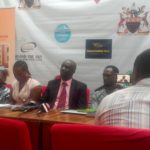
A Uganda Sickle Surveillance study conducted on 93,316 individuals across the country has found that the sickle cell burden is lower in HIV positive Infants.
The Early Infant Diagnosis (EID) study which was flagged off in February last year predicted that amongst HIV positive infants, 5.1 were normal, 5.0 had the trait and 3.0 had the disease.
Amongst HIV negative infants, the study discovered that 94.9 were normal, 95.0 had the trait and 97.0 had the disease.
This study was conducted by the Division of Hematology and Global Health Center Cincinnati Children’s hospital, Makerere University, CPHL Sickle Cell laboratory and the Ministry of Health.

Out of the total of 93,316 screened; 664 had the disease, 12,283 have the trait, 79,943 were normal and 426 were variant. The study discovered that Northern and Central regions had the highest values of the Sickle Cell disease.
Of the 112 districts subjected to study, 14 districts contain 47% (312 out of 664) of the sickle cell disease. These districts are Kampala, Gulu, Lira, Jinja, Tororo, Luweero, and Wakiso, Apac, Iganga, Mayuge, Buikwe, Oyam, Masaka and Masindi.
It is from these findings that Professor Grace Ndeezi from the Department of Pediatric and Child Health- Makerere University College of Health sciences suggested that screening of the disease should mainly focus on these highest burden regions.
The Minister of Health for Primary Health Care, Sarah Opendi, acknowledge that this survey has come at the right time when government had limited knowledge on the Sickle Cell disease and was operating on old statistics.
“We cannot plan and allocate resources without data. These results have availed us with enough data to come up with a Sickle Cell control strategy,” Opendi said.
These study findings were revealed during a scientific conference on the Sickle Cell Burden in Uganda at the senate building Makerere University and later crowned by the free national Sickle Cell screening exercise at the University’s freedom square.
gamme@eagle.co.ug







Yolonews.us covers local news in Yolo County, California. Keep up with all business, local sports, outdoors, local columnists and more. https://yolonews.us/